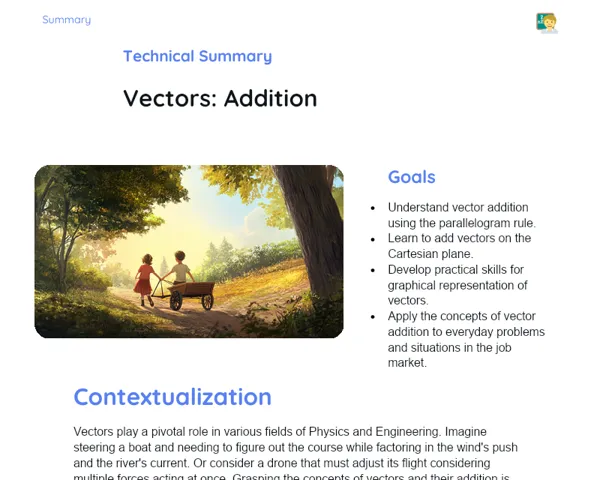Socioemotional Summary Conclusion
Goals
1. Understand the polarization of light and how to observe it using different polarizers.
2. Relate the intensity of incident light to the intensity of transmitted light through a polarizer, employing mathematical and physical principles.
Contextualization
Did you know that the sunglasses you wear can enhance your understanding of physics? Polarized sunglasses cut down glare from reflective surfaces like water or roads. By grasping the concept of light polarization, not only can we improve our vision, but we also unlock opportunities for technological advancements in various fields, such as LCD screens and photography. Let's journey together to see how we can manipulate light and discover practical tips for our daily lives!
Exercising Your Knowledge
Definition of Light Polarization
Light polarization refers to the orientation of the electric field oscillations within a light wave. In unpolarized light, these oscillations occur in multiple directions perpendicular to the direction of propagation. In polarized light, the oscillations are confined to a single direction. Grasping this concept is essential for understanding how light interacts with different materials, including polarizers, and how we can control these interactions.
-
Unpolarized Light: Fluctuates in various directions perpendicular to its direction of travel, like sunlight.
-
Polarized Light: Fluctuates in a single direction, which can be linear, circular, or elliptical.
-
Importance: Recognizing the difference is crucial for a range of applications, from polarized sunglasses to optical communication technologies.
Types of Polarization
There are three primary types of polarization: linear, circular, and elliptical. In linear polarization, light moves in a straight line. In circular polarization, light moves in a circle, whereas in elliptical polarization, it moves in an elliptical path. Each type has distinct characteristics and practical applications, assisting us in choosing the right method to polarize light for various uses.
-
Linear Polarization: The simplest form, where light oscillates along a single plane. It's used in various applications, including glasses and camera filters.
-
Circular Polarization: Light oscillates in a circular pattern, commonly utilized in telecommunications engineering.
-
Elliptical Polarization: Merges features of the previous two types and is used in more specialized and technical applications.
Malus's Law
Malus's Law is a mathematical expression that describes the link between the intensity of light passing through a polarizer and the angle of polarization. The equation is expressed as I = I0 * cos²(θ), where I is the intensity of transmitted light, I0 is the intensity of incident light, and θ represents the angle between the direction of incident light polarization and the polarizer's polarization direction. This law is fundamental for determining how much light passes through polarizing filters at various angles.
-
Formula: I = I0 * cos²(θ).
-
Transmitted Intensity: Directly linked to the angle between the incident light and the polarizer.
-
Applications: Essential in designing optical devices like LCD screens and communication systems.
Key Terms
-
Light Polarization: Refers to the orientation of the electric field oscillations in light waves.
-
Unpolarized Light: Light that oscillates in multiple directions perpendicular to its path.
-
Polarized Light: Light that oscillates in a single direction.
-
Linear Polarization: Light oscillating in a single plane.
-
Circular Polarization: Light oscillating in a circular manner.
-
Elliptical Polarization: Light oscillating in an elliptical fashion.
-
Malus's Law: A formula that relates the light intensity transmitted through a polarizer to the polarization angle.
For Reflection
-
How can understanding light polarization enhance our daily activities, especially when using polarized sunglasses, and how can this relate to managing our own emotions?
-
Have you ever faced a situation where you felt 'polarized' emotionally? How did you navigate through it? What strategies can you adopt to manage those emotions more effectively moving forward?
-
In what ways did working as a group during the experiment with polarizers strengthen your social and emotional competencies, and how can you apply those insights in other aspects of your life?
Important Conclusions
-
We comprehended the essence of light polarization and how to observe it with different polarizers.
-
We connected the intensity of the incident light to the intensity of the transmitted light using Malus's Law.
-
We examined the varieties of polarization - linear, circular, and elliptical - along with their practical implications.
-
We engaged in hands-on activities to visualize and deepen our understanding of light polarization.
-
We nurtured our socio-emotional skills through group collaboration and reflecting on our feelings during the activities.
Impacts on Society
Light polarization significantly influences our day-to-day lives. For instance, polarized sunglasses alleviate glare from surfaces like water and roads, enhancing safety and comfort while driving. Furthermore, polarization plays a critical role in technologies we frequently use, such as the LCD displays in our smartphones and televisions, which manage light to produce vivid and clear images.
Beyond practical considerations, exploring polarization prompts us to think about controlling and directing our emotions. Much like how light can be polarized in a particular direction, we can learn to regulate our emotions to align with our objectives and values. This underscores the importance of self-awareness and emotional regulation for a balanced lifestyle and healthy social connections.
Dealing with Emotions
Let's practice a simple activity at home to better manage our emotions while studying light polarization. First, acknowledge any feelings that may surface, be it frustration or excitement, while studying. Next, understand what triggers the emotion - is it the topic's difficulty or the joy of learning something new? Name that emotion accurately and then express it suitably. For instance, if you feel frustrated, consider taking a break and practicing a few deep breaths. Finally, regulate your emotions by seeking ways to motivate yourself, such as enjoying a snack break or discussing the topic with a classmate.
Study Tips
-
Review your class notes as soon as you get home to reinforce your learning.
-
Utilize visual aids like videos and online simulations to grasp the concepts of polarization better.
-
Practice applying Malus's Law and solving relevant problems in everyday contexts, like assessing optical devices.



